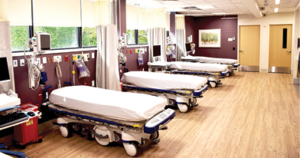WP Hospital has new surgical center up and running
White Plains Hospital has unveiled its ambulatory surgery center at 226 Westchester Ave. in Harrison, located amidst a 14-acre complex of medical buildings that was bought in 2014 by Healthcare Trust of America Inc.
 The hospital signed a lease in September 2019 and then did a full building gut and renovation. The hospital also has 12,000 square feet at 222 Westchester Ave., which is orthopedics and physical therapy, and 7,500 square feet at 244 Westchester Ave., which is radiology.
The hospital signed a lease in September 2019 and then did a full building gut and renovation. The hospital also has 12,000 square feet at 222 Westchester Ave., which is orthopedics and physical therapy, and 7,500 square feet at 244 Westchester Ave., which is radiology.
The hospital”™s 10,000-square-foot surgery center features four operating rooms along with preparation and recovery areas. The hospital said that the center treated its first patients early in October and is expected to handle more than 2,100 cases during its first year. The hospital has positioned the facility as an adjunct to its center for advanced medicine and surgery, which is under construction at Longview and Maple avenues in White Plains and is expected to open next year.
“In the past, patients would have to come into the hospital for what now can be done in an outpatient setting safely,” Dr. Kaare Weber, director of surgery at White Plains Hospital told the Business Journal.
“When considering what”™s appropriate for an ambulatory surgery center, we take into account both the patient”™s risk factors and comorbidities as well as the type of procedure and inherent risks to that operation. With that, we are looking to do procedures in orthopedics, ENT, plastic surgery as well as cosmetic surgery and those procedures would be appropriate for the outpatient setting where they could be done in a timely fashion with minimal risk but also importantly on patients who are otherwise healthy or do not have significant comorbidities.”
Weber said that sports medicine procedures such as rotator cuff repairs, tendon repairs and hand surgery are well-suited to being performed in an ambulatory surgery facility. He said that board-certified surgeons and anesthesiologists are offering a wide range of minimally invasive procedures at the center.
“I think the minimally invasive techniques have certainly contributed to the ability for surgeons to do these procedures in the outpatient setting,” Weber said. “It has to be in the right setting. By example, the sports-related procedures on young healthy individuals are ideal for an off-site ambulatory surgery center.”
Weber added that some other procedures are better suited for being done in a hospital setting even though the patients may be sent home the same day. He noted that some years ago, White Plains Hospital dedicated three operating rooms within the main hospital for procedures where patients did not need to remain hospitalized during their recovery.
“Our center for advanced medicine and surgery is anticipated to open in July and in there, among other things, it will house six operating rooms and three procedure rooms; there, we can do more advanced, complex, minimally invasive procedures such as laparoscopic procedures and general surgery for gallbladder disease, hernia disease, gynecologic problems. The building will even house a new robot that is an extension of minimally invasive techniques. The advantage is that should there be a problem or any concerns, the patient may need to stay overnight, we have direct access to the hospital through a physical connection with bridges, and that really sets us apart from the other freestanding ambulatory surgery centers. It really gives us that extra measure of safety.”
Weber said that the Harrison center is already fully staffed with individuals having extensive experience in the ambulatory surgery field.
“White Plains Hospital was at the forefront of ambulatory surgery decades ago,” Weber said, but added that the hospital is outgrowing its footprint. “The hospital was recently approved to do cardiac surgery, so with the expansion of this complex care we needed to create space. The ideal setting would be in a freestanding center where patients don”™t have to come into the hospital and navigate the hallways of a system where there are also inpatients. So, the vision really was to remove any outpatient procedures that are currently being done in the hospital to a different setting.”
Weber explained that he has several functions in his role as director of surgery for the hospital.
“I remain quite active clinically as a surgeon. My expertise is endocrine surgery so I focus on the diseases of the thyroid, parathyroid and adrenal in my clinical practice.”
He said administratively he is involved in program growth and development for the hospital including modernization of the inpatient operating rooms and intensive care units.
“A large part of my role also includes the patient experience around patient satisfaction and efficiency but most importantly, and really where my passion lies is, around patient safety and quality,” Weber said. “In my role I am what”™s called the surgeon champion for the American College of Surgeons”™ quality program.” He said that the program involves following patients”™ progress after surgery not only when recovering in the hospital but for at least a month after they leave the hospital to make sure they”™re doing well.
“I”™m proud to say that we were recognized for the second year in a row by the American College of Surgeons for being a top 10% performing hospital in outcomes,” Weber said. “We were recently awarded what”™s known as meritorious status for our surgical outcomes here at White Plains Hospital.”